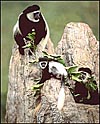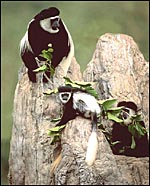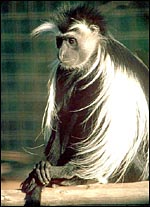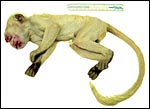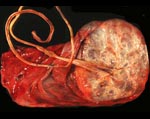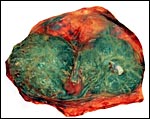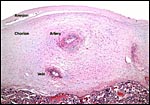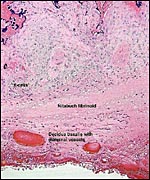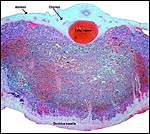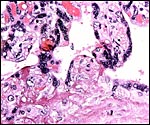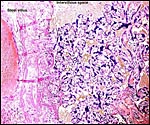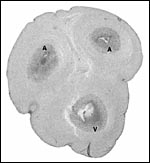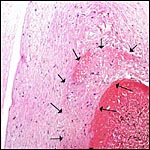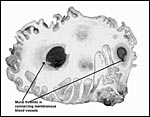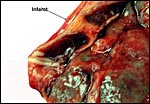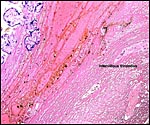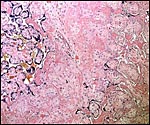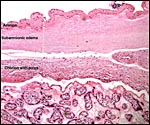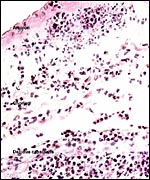| |
16)
Physiologic data
I know of no relevant data
17)
Other resources
Cell lines are available of several colobus species from CRES
at the San Diego Zoo by contacting Dr. Oliver Ryder at oryder@ucsd.edu.
18) Other remarks - What additional Information is needed?
Early implantations, a pregnant uterus to delineate depth of trophoblast
invasion, and endocrine data would be desirable.
Acknowledgement
The animal photographs in this chapter come from the Zoological Society
of San Diego. I appreciate also very much the help of the pathologists
at the San Diego Zoo.
References
Banish, L.D., Sims, R., Sack, D., Montali, R.J., Phillips, L. Jr. and
Bush, M.: Prevalence of shigellosis and other enteric pathogens in a zoological
collection of primates. JAVMA 203:126-132, 1993.
Baur,
R.: Uber die Relation zwischen Zottenoberfläche der Geburtsplacenta
und Gewicht des Neugeborenen bei verschiedenen Säugetieren. Z. Anat.
Entwickl.-Gesch. 13131-38, 1970.
Bender,
M.A. and Chu, E.H.Y.: The chromosomes of primates. Chapter 7 (pp.261-310)
in, Evolutionary and Genetic Biology of Primates, Vol. 1. J. Buettner-Janusch,
ed. Academic Press, NY 1963.
Benirschke,
K. and Miller, C.J.: Anatomical and functional differences in the placenta
of primates. Biol. Reprod. 26:29-53 1982.
Boever,
W.J. and Kern, T.: Papillomas in black and white colobus monkeys (Colobus
polykomus). J. Wildl. Dis. 12:180-181, 1976.
Chiarelli,
B.: Comparative morphometric analysis of the primate chromosomes. III.
The chromosomes of the genera Hylobates, Colobus, and Presbytis.
Caryologia 16:637-648, 1963.
Courgnaud,
V., Pourrut, X., Bibollet-Ruche, F., Mpoudi-Ngole, E., Bourgeois, A.,
Delaporte, E. and Peeters, M.: Characterization of a novel simian immunodeficiency
virus from guereza colobus monkeys (Colobus guereza) in Cameroon:
a new lineage in the nonhuman primate lentivirus family. J. Virol. 75:857-866
200.
Eberhard,
M.L., Njenga, M.N., DaSilva, A.J., Owino, D., Nace, E.K., Won, K.Y. and
Mwenda, J.M.: A survey for Cyclospora spp. in Kenyan primates, with some
notes on its biology. J. Parasitol. 87:1394-1397, 2001.
Ensley,
P.K., Fagan, D. and Reichard, T.: Sialolithiasis in a Colobus monkey.
JAVMA 179:1297-1299, 1981.
Farah,
I.O., Chege, G.K. and Riday, A.M.: Acute gastric dilatation in two black
and white colobus monkeys. J. Med. Primatol. 22:278-279, 1993.
Gotch,
A.F.: Mammals - Their Latin Names Explained. Blandford Press, Poole, Dorset,
1979.
Gray,
A.P.: Mammalian Hybrids. A Check-list with Bibliography. 2nd edition.
Commonwealth Agricultural Bureaux Farnham Royal, Slough, England, 1972.
Griner,
L.A.: Pathology of Zoo Animals. Zoological Society of San Diego, San Diego,
California, 1983.
Groves,
C.P.: The forgotten leaf-eaters, and the phylogeny of the colobinae. Pp.
555-586, in: Old World Monkeys. Evolution, Systematics and Behavior. Napier
& Napier, eds. Academic Press, NY, 1970.
Hollihn,
U: Remarks on the breeding and maintenance of Colobus monkeys Colobus
guereza, Proboscis monkeys Nasalis larvatus and Douc langurs Pygathrix
nemaeus in zoos. Intern. Zoo Yearb. 13:185-188, 1973.
Houston,
M.L.: The development of the baboon (Papio sp.) placenta during
the fetal period of gestation. Amer. J. Anat. 126:17-30, 1969.
Jones,
M.: Personal communication, 1977.
Lang
E.M.: Ein Colobus-Bastard. Zool. Garten 43:161-1, 1973
Lee,
C., Stanyon, R., Lin, C.C. and Ferguson-Smith, M.A.: Conservation of human
gamma-X centromeric satellite DNA among primates with an autosomal localization
in certain Old World monkeys. Chromosome Res.7:43-47 1999.
Loomis,
M.R., O'Neill, T., Bush, M. and Montali, R.J.: Fatal herpesvirus infection
in patas monkeys and a black and white colobus monkey. JAVMA 179:1236-1239,
1981.
Nowak,
R.M.: Walker's Mammals of the World. 6th ed. The Johns Hopkins Press,
Baltimore, 1999.
Page,
S.L., Chiu, Ch. and Goodman, M.: Molecular phylogeny of Old World monkeys
(Cercopithecidae) as inferred from gamma-globin D sequences. Mol.
Phylogenet. Evol. 13:348-359, 1999.
Rangan,
S.R.S., Gutter, A., Baskin, G.B. and Anderson, D.: Virus associated papillomas
in Colobus monkeys (Colobus guereza). Lab. Anim. Sci. 30:885-889
1980
Reszka,
A.A., Sundberg, J.P. and Reichman, M.E.: In vitro transformation and molecular
characterization of Colobus monkey venereal papillomavirus DNA. Virology
181:787-72, 1991.
Rideout,
B.A., Gardiner, C.H., Stalis, I.H., Zuba, J.R., Hadfield, T. and Visvesvara,
G.S.: Fatal infections with Balamuthia mandrillaris (a free-living
amoeba) in gorillas and other Old World primates. Vet. Pathol. 34:15-22,
1997.
Schultz,
A.H.: The occurrence and frequency of pathological and teratological conditions
and of twinning among non-human primates. Pp. 966-1014, in: Primatologia.
Vol. I. H. Hofer, A.H. Schultz, and D. Starck, eds. Karger, Basel, 1956.
Scott,
G.B.D.: Comparative Primate Pathology. Oxford University Press, 1992.
Scott,
G.B. and Keymer, I.F.: The pathology of measles in Abyssinian Colobus
monkeys (Colobus guereza): a description of an outbreak. J. Pathol.
117:229-233, 1975.
Soave,
O.A.: Observations on acute gastric dilatation in nonhuman primates. Lab.
Anim. Sci. 28:331-334, 1978.
Stetter,
M.D., Mikota, S.K., Gutter, A.F., Monterroso, E.R., Dalovisio, J.R., Degraw,
C. and Farley, T.: Epizootic of Mycobacterium bovis in a zoological
park. J. Amer. Vet. Med. Assoc. 207:1618-1621, 1995).
Tague,
R.G.: Variability of metapodials in primates with rudimentary digits:
Ateles geoffroyi, Colobus guereza, and Perodicticus potto.
Amer. J. Phys. Anthropol. 117:195-20, 2002.
|
